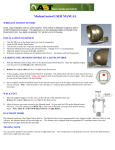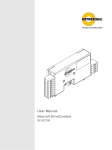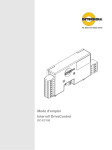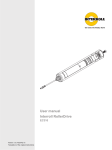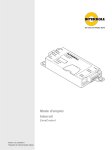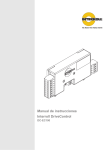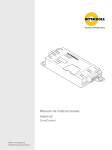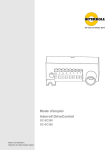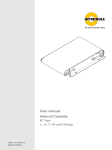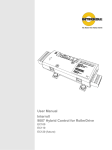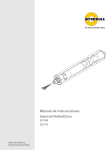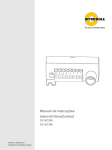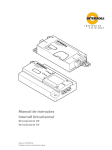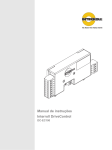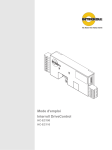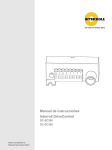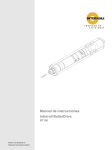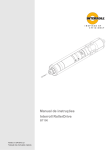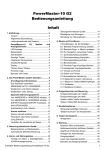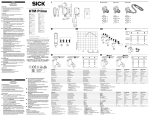Download User manual Interroll
Transcript
User manual Interroll ZoneControl Chapter-ID: User manual Chapter-ID: Version Chapter-ID: Translation of the original instructions Version 1.0 (12/2010) en Translation of the original instructions Manufacturer's address Interroll Engineering GmbH Hoeferhof 16 D-42929 Wermelskirchen Tel. +49 2193 23 0 Fax. +49 2190 2022 www.interroll.com Copyright The copyright of this manual remains with Interroll Engineering GmbH. The operating instructions contain technical regulations and drawings which may not be reproduced partially or in full, transmitted by any means, utilized without permission for competitive purposes or disclosed to third parties. Version 1.0 (12/2010) en Translation of the original instructions ZoneControl Table of contents Introduction Information about the operating instructions . . . . . . . . . . . . . . . . . . . . . . . . 3 Warnings in this manual . . . . . . . . . . . . . . . . . . . . . . . . . . . . . . . . . . . . . . . 3 Further symbols . . . . . . . . . . . . . . . . . . . . . . . . . . . . . . . . . . . . . . . . . . . . . 4 Safety General safety instructions . Intended use . . . . . . . . . . . Unintended use . . . . . . . . . Qualified persons . . . . . . . . Dangers . . . . . . . . . . . . . . . Interfaces to other devices . Operating modes . . . . . . . . . . . . . . . . . . . . . . . . . . . . . . . . . . . . . . . . . . . . . . . . . . . . . . . . . . . . . . . . .... .... .... .... .... .... .... ... ... ... ... ... ... ... .... .... .... .... .... .... .... ... ... ... ... ... ... ... .... .... .... .... .... .... .... ... ... ... ... ... ... ... .... .... .... .... .... .... .... ... ... ... ... ... ... ... 5 5 5 6 7 7 7 Product information Product description . Components. . . . . . . Scope of delivery . . . Label . . . . . . . . . . . . Technical data . . . . . Meaning of the LEDs DIP switches . . . . . . Meaning of signals . . Dimensions . . . . . . . . . . . . . . . . . . . . . . . . . . . . . . . . . . ... ... ... ... ... ... ... ... ... .... .... .... .... .... .... .... .... .... ... ... ... ... ... ... ... ... ... ............................ 8 . . . . . . . . . . . . . . . . . . . . . . . . . . . 11 . . . . . . . . . . . . . . . . . . . . . . . . . . . 11 . . . . . . . . . . . . . . . . . . . . . . . . . . . 11 . . . . . . . . . . . . . . . . . . . . . . . . . . . 12 . . . . . . . . . . . . . . . . . . . . . . . . . . . 12 . . . . . . . . . . . . . . . . . . . . . . . . . . . 13 . . . . . . . . . . . . . . . . . . . . . . . . . . . 14 . . . . . . . . . . . . . . . . . . . . . . . . . . . 14 Transport and storage Ambient conditions for transport and storage . . . . . . . . . . . . . . . . . . . . . . 15 Transport . . . . . . . . . . . . . . . . . . . . . . . . . . . . . . . . . . . . . . . . . . . . . . . . . 15 Storage . . . . . . . . . . . . . . . . . . . . . . . . . . . . . . . . . . . . . . . . . . . . . . . . . . 15 Assembly Warning notices concerning assembly . . . . . . . . . . . . . . . . . . . . . . . . . . . Warning information relating to the electrical installation . . . . . . . . . . . . . Installing the ZoneControl in a conveyor system . . . . . . . . . . . . . . . . . . . Electrical installation . . . . . . . . . . . . . . . . . . . . . . . . . . . . . . . . . . . . . . . . Sensors . . . . . . . . . . . . . . . . . . . . . . . . . . . . . . . . . . . . . . . . . . . . . . . . . . Inputs and outputs . . . . . . . . . . . . . . . . . . . . . . . . . . . . . . . . . . . . . . . . . . Wiring diagrams . . . . . . . . . . . . . . . . . . . . . . . . . . . . . . . . . . . . . . . . . . . . 16 16 17 17 19 20 22 Initial startup and operation Commissioning . . . . . . . . . . . . . . . . . . . . . . . . . . . . . . . . . . . Operation . . . . . . . . . . . . . . . . . . . . . . . . . . . . . . . . . . . . . . . . Speed setting . . . . . . . . . . . . . . . . . . . . . . . . . . . . . . . . . . . . . External influence on zero pressure accumulation conveying . Complete clearing of a conveyor . . . . . . . . . . . . . . . . . . . . . . ... ... ... ... ... .... .... .... .... .... .. .. .. .. .. 26 26 27 27 29 Maintenance and cleaning Warnings concerning maintenance and cleaning . . . . . . . . . . . . . . . . . . . 30 Maintenance . . . . . . . . . . . . . . . . . . . . . . . . . . . . . . . . . . . . . . . . . . . . . . 30 Cleaning . . . . . . . . . . . . . . . . . . . . . . . . . . . . . . . . . . . . . . . . . . . . . . . . . 30 Troubleshooting Troubleshooting . . . . . . . . . . . . . . . . . . . . . . . . . . . . . . . . . . . . . . . . . . . . 31 Deviations in the conveying process . . . . . . . . . . . . . . . . . . . . . . . . . . . . 32 Abandonment and disposal Abandonment. . . . . . . . . . . . . . . . . . . . . . . . . . . . . . . . . . . . . . . . . . . . . . 33 Disposal . . . . . . . . . . . . . . . . . . . . . . . . . . . . . . . . . . . . . . . . . . . . . . . . . . 33 Version 1.0 (12/2010) en Translation of the original instructions 1 ZoneControl Table of contents Appendix Electrical data of connectors . . . . . . . . . . . . . . . . . . . . . . . . . . . . . . . . . . . 34 Installation Declaration . . . . . . . . . . . . . . . . . . . . . . . . . . . . . . . . . . . . . . . 37 2 Version 1.0 (12/2010) en Translation of the original instructions ZoneControl Introduction Information about the operating instructions Contents Validity of the manual This manual contains important advice, notes and information about the ZoneControl in all phases of its lifecycle: • Transport, assembly and start-up • Safe operation, maintenance and troubleshooting, disposal • Accessories The manual describes the ZoneControl as it is delivered by Interroll. In addition to this manual, special contractual agreements and technical documents apply to special versions. The manual is part of the product ¾ For trouble-free, safe operation and warranty claims, read the manual and follow the instructions before handling the ZoneControl. ¾ Keep the manual near to the ZoneControl. ¾ Pass the manual on to any subsequent operator or occupant of the ZoneControl. ¾ Interroll does not accept any liability for malfunctions or defects due to nonobservance of this manual. ¾ If you have any questions after reading the operation manual, feel free to contact our customer service. See the last page for your local contact. Warnings in this manual The warnings in this document refer to risks which may arise while using the ZoneControl. For relevant warnings, see "Safety", page 5 and the warnings at the beginning of each chapter. There are three categories of danger. The following signal words are used in the document as required: • Danger • Warning • Caution Signal word Meaning Danger Indicates a hazardous situation which, if not avoided, will result in death or serious injury. Warning Indicates a hazardous situation which, if not avoided, could result in death or serious injury. Caution Indicates a hazardous situation which, if not avoided, may result in minor or moderate injury. Structure of warnings DANGER Nature and source of the hazard Possible consequence of non-observance ¾ Information about how to avoid the hazard. Version 1.0 (12/2010) en Translation of the original instructions 3 ZoneControl Introduction Further symbols This symbol identifies possible material damage. ¾ Information about how to avoid damage. Important This symbol displays safety instructions. Hint This symbol marks useful and important information. ¾ This symbol marks the steps that have to be carried out. 4 Version 1.0 (12/2010) en Translation of the original instructions ZoneControl Safety General safety instructions The ZoneControl is designed according to the technical state of the art and is reliable in operation, once distributed. However, risks may still arise. • Risks of physical injury to the user or bystanders. • Adverse effects of the ZoneControl and other material. Important Disregarding the warnings in this manual may lead to serious injury. ¾ Always read the entire operating and safety instructions before starting to work with the ZoneControl and follow the information contained herein in full. ¾ Only instructed and qualified persons may work with the ZoneControl. ¾ Always keep this user manual at hand when working on the ZoneControl so that you can consult it quickly if required. ¾ Always comply with relevant national safety regulations. ¾ If you have any questions after reading this user manual, feel free to contact our customer service. See the last page for contact information. Intended use The ZoneControl should only be used for industrial applications and in an industrial environment to control one of the following RollerDrives: • RollerDrive EC310 • RollerDrive EC300 (with adapter cable) It must be integrated into a conveyor module or conveyor system. Any other use is not permitted and is deemed to be improper. Any modifications that affect the safety of the product are not permitted. The ZoneControl may only be operated within the defined operating limits. The ZoneControl must be supplied by a regulated power supply unit with a nominal DC voltage of 24 V (minimum 19 V, maximum 26 V). Unintended use Applications not according to the intended use of the ZoneControl require approval from Interroll. Version 1.0 (12/2010) en Translation of the original instructions 5 ZoneControl Safety Qualified persons Qualified persons are persons who read and understand the manual and, taking national regulations into account, can competently execute incidental work. Only instructed and qualified persons may work with the ZoneControl, taking the following into account: • the relevant manuals and diagrams, • the warning and safety instructions in this manual, • the system specific regulations and requirements, • national or local regulations and requirements for safety and accident prevention. 6 Version 1.0 (12/2010) en Translation of the original instructions ZoneControl Safety Dangers Important The following list informs you about the various types of danger or damage that may occur while working with the ZoneControl. Persons Electricity ¾ Maintenance or repair work must only be executed by authorized and qualified persons in accordance with the applicable regulations. ¾ Before using the ZoneControl, ensure that no unauthorized persons are near the conveyor. ¾ Only operate the ZoneControl with control voltage complying with the requirements of EN 60401-1, PELV. ¾ Only perform installation and maintenance work after you have switched off the power. ¾ Ensure that the power cannot be turned on accidentally. Working environment ¾ Do not use the ZoneControl in explosive environments. ¾ Always remove materials and objects which are not required from the work area. Malfunctioning during operation ¾ Regularly check the ZoneControl for visible damage. ¾ In case of fumes, turn off the power at once and ensure that it cannot be turned on accidentally. ¾ Contact qualified personnel immediately to find the source the malfunction. Maintenance ¾ As the product is maintenance free, you only need to check the ZoneControl regularly for visible damage and that all leads and screws are still tightened. Interfaces to other devices By assembling the ZoneControl in a conveyor module, further hazards may occur. These hazards are not part of this manual and have to be analyzed during the design, installation and startup of the conveyor module. ¾ After assembling the ZoneControl in a conveyor module, check the whole system for a new potential dangerous spot before switching on the conveyor. Operating modes Normal mode Operation of the installed device at the end customer's as a component in a conveyor in a complete system. Special mode All operating modes which are required to guarantee and maintain safe and normal operation. Special operating mode Explanation Comment Transport/Storage Loading and unloading, transport and storage - Assembly/Initial start-up Installation at the end customer's and performing the test run When de-energized Cleaning External cleaning When de-energized Maintenance/Repairs Maintenance and inspection tasks When de-energized Troubleshooting Troubleshooting in the event of a fault When de-energized Fault elimination Eliminating the fault When de-energized Shut-down Dismantling from the conveyor When de-energized Disposal Disposal of ZoneControl and packaging - Version 1.0 (12/2010) en Translation of the original instructions 7 ZoneControl Product information Product description The ZoneControl is used to facilitate zero pressure accumulation conveying, meaning that goods are transported without coming into contact with each other. To achieve this, the conveyor is sub-divided into zones. One zone consists of a RollerDrive, several idler rollers, a ZoneControl and corresponding sensors. Zero pressure accumulation conveying is achieved by there being only one product in every zone and by the zones retaining the package until the downstream zone is detected as being "free" by the corresponding sensor. When accumulation occurs, a signal is transmitted upstream to retain the next package. A gap is always left between the goods being transported so that no accumulation pressure occurs. Schematic diagram: three zones controlled by ZoneControl 1 2 3 4 5 Zone 1 Zone 2 Zone 3 Direction of travel ZoneControl 6 7 8 9 bl Zone sensor RollerDrive Power supply Peer-to-peer connection Package The sensor in zone 1 has detected a package. The ZoneControl in zone 1 sends a request to zone 2 to ask whether the package can continue to be conveyed. Since zone 2 also contains a package, its ZoneControl denies permission until this package has been transferred to zone 3 (singulated release mode) or at the very least its onward transport has been started. In singulated release mode, the package is only conveyed on if the package in the downstream zone has fully left this zone. In train release mode, the packages are virtually transported simultaneously (with a time delay of approx. 125 ms to reduce peak current when starting up.) The ZoneControl in zone 1 only activates the RollerDrive in this zone after it receives the corresponding signal from the ZoneControl in zone 2. 8 Version 1.0 (12/2010) en Translation of the original instructions ZoneControl Product information Functions • • • • • • Speed settings The speed and direction of rotation of a RollerDrive EC310 (or EC300 with adapter cable) can be controlled. The signals from two sensors (start and zone sensors) can be evaluated. The feeding of packages into the start zone can be controlled by a sensor or by an external signal. Transport logic can be influenced by external control signals (ZONE_START, ZONE_STOP, ZONE_STATUS, CLEAR, DIR_RET), enabling different functions: – Automatic stop at personal gates – Individual zone stops within the conveyor line – Clearing the entire system in or against the set direction of rotation – Feed-in/removal of packages outside of the start and end zone (for instance in conjunction with an external handling system) The control signals can either be processed in PNP mode or in NPN mode. Regenerative braking: When the RollerDrive motor brakes, it acts as a generator and feeds energy back into the power supply. The DriveControl is fitted with a brake chopper. The speed of the RollerDrive can be adjusted in two different ways by ZoneControl: • Internally at eight levels by means of three DIP switches • Externally continuously via the analog input SPEED (is handled with priority and enables more fine-tuned adjustment) The speed setting is converted to an analog control voltage by the ZoneControl and output by the RollerDrive as a reference setting. This reference setting is independent of the RollerDrive gears and their diameter. Speed setting of the see "Speed setting", page 27. The acceleration and braking behaviour of the RollerDrive is defined by its own moment of inertia, the gears used, the conveying speed, the moment of inertia of connected conveyor rollers, the selected torque transmission and the goods transported. Feedback of energy / Overvoltage protection Version 1.0 (12/2010) en Translation of the original instructions If the RollerDrive is stopped by the ZoneControl or if the speed is reduced abruptly, the kinetic energy of the package is regeneratively converted into electrical energy in the motor. This energy is then fed back into the ZoneControl, resulting in increased voltage in the DC-net. This is limited to a non-critical level (28 V) by the integral brake chopper. However, if there are enough other consumers attached to the DC-net, the voltage rise will be low and the energy will be fed back in, resulting in the energy being available to other consumers in the DC-net and energy-savings being made if conditions are favourable. 9 ZoneControl Product information Temperature protection If operational conditions mean that the brake chopper is switched on so often that the upper temperature limit of approx. 90 °C (measured internally) is reached, then the ZoneControl switches off. If temperature protection is active, this is shown on the LED display. When the ZoneControl has cooled down, the RollerDrive restarts automatically when a signal is pending. CAUTION Unintended start-up of the RollerDrive following the ZoneControl cooling down Danger of crushing of limbs and damage to goods ¾ Ensure that no start signal is pending during the cooling-down process. Lock period for signal modifications / Debouncing The external signal inputs, the sensor connections and the DIP switches are protected by the firmware to guarantee operation in the event of edge-unstable and bouncing input-levels. This means that after a signal status change, there is a time gap of 20 ms in which no additional status change is accepted. The sample applies to the sensor inputs, where signal status changes are only processed 50 ms after a signal modification. P 1 t 0 tx 1 2 3 After-run time Signal (with effect) and start of the lock time tx Signals with no effect, as they lie within the lock time t x The first signal that has an effect after the lock time tx Once a package has left the sensor of a zone, then the RollerDrive in this zone continues to run for additional 4 seconds. At the end of 4 seconds, the RollerDrive stops, providing no new package is transferred from the upstream zone. This feature provides the following benefits: • Energy-savings by switching off the RollerDrive if no further packages have to be transported. • Avoidance of unnecessary start/stop operation if there are no gaps between the packages. 10 Version 1.0 (12/2010) en Translation of the original instructions ZoneControl Product information Components ZoneControl 1 2 3 4 5 6 Upstream PTP connector 1) Zone sensor connector Start sensor connector RollerDrive connector Mounting link with hole for countersunk screw Power supply connector 7 8 9 bl bm 1) Inputs/outputs connectors Downstream PTP connector Cover for DIP switches Marker (changeable) Red and green LED 1) PTP = Peer-to-Peer connection Scope of delivery The ZoneControl contains the following components: • ZoneControl • Mating plug for power supply (WAGO 734-102/xxx-xxx) • Mating plug for inputs/outputs (WAGO 733-108/xxx-xxx) • Spare tool for power supply mating plug (black) • Spare tool for inputs/outputs mating plug (yellow) Label The information on the label is used to identify the ZoneControl. ZoneControl for RollerDrive 123456789 123456789 06/10 Interroll Enineering GmbH 42929 Wermelskirchen • Germany www.interroll.com ZoneControl 1 2 3 Version 1.0 (12/2010) en Translation of the original instructions Manufacturer Product name Week and year of production 4 5 6 Manufacturer's address Article number Serial number 11 ZoneControl Product information Technical data Rated voltage 24 V DC Voltage range 19 to 26 V DC (no polarity protection)1) Current consumption with RollerDrive: 3 to 5 A without RollerDrive: 0.08 A to 0.5 A Protection classification IP20 Cooling Convection Ambient temperature in operation 0 °C to 40 °C (32 °F to 104 °F) Air humidity 5 to 95 %, condensation not permissible Installation height above sea level max. 1,000 m (max. 3,300 ft) 1) A single ZoneControl is protected against reverse polarity connection of the operation voltage. Polarity protection is gone as soon as assemblies are connected via PTP. Meaning of the LEDs The LEDs indicate the operating condition of the ZoneControl and the RollerDrive and provide information about the operating voltage. LED green LED red Meaning Behaviour of RollerDrive 2) Flashing Initialisation of ZoneControl Depending on sensor assignment Off ZoneControl ready for operation Stop Off RollerDrive receives start signal Rotates On steady Flashes once 2) RollerDrive faulty or not connected Stop On steady Flashes twice 2) Fault in conveyor process (for instance jammed package) Stop On steady Flashes three times 2) Shutdown due to excessive temperature in chopper resistance Stop Off Flashes four times 2) System error (for instance PTP cable disconnected) Stop Off On steady Fuse triggered Stop Flashing On steady Flashing 2) 2) 2) Depending on the error, the LED flashes in different sequences (0.5 s on - 0.5 s off) within a period of 4 seconds. 12 Version 1.0 (12/2010) en Translation of the original instructions ZoneControl Product information DIP switches The DIP switches can be used to select the speed, direction of transportation, operating mode and logic conversion (PNP/NPN). Factory default of the DIP switches 1 to 3 is ON and that of DIP switches 4 to 8 is OFF. DIP switches ON OFF DIP SPEED A, B, C Speed setting (see "Speed setting", page 27) DIP EPA/BA Train release mode (BA) DIP DIR RollerDrive rotates in an anticlockwise direction 2) 1) DIP PNP/NPN Signals are emitted in accordance with NPN logic 1) Singulated release (EPA) 1) RollerDrive rotates in a clockwise direction 2) Signals are emitted in accordance with PNP logic see "Product description", page 8 2) The direction of rotation is seen from the connecting cable side, if the external input DIR_RET is not switched. Combined with a signal at the CLEAR signal input, the direction of rotation is reversed if the DIR_RET input is switched. DIP switches on the ZoneControl 1 2 3 4 5 6 Version 1.0 (12/2010) en Translation of the original instructions SPEED A SPEED B SPEED C EPA/BA DIR PNP/NPN 13 ZoneControl Product information Meaning of signals ZONE_STATUS The ZONE_STATUS signal is the output signal of the handshake function of the ZoneControl. The assigned signal input is ZONE_START. The ZONE_STATUS signal is active when: • The ZONE_START signal is active. • The start or zone sensor is occupied (by regular in-feed of a package or by placing a package on a previously empty zone). The ZONE_STATUS signal gets in-active when: • A package initially standing is conveyed into the following zone. When the zone sensor becomes free, the ZONE_STATUS gets in-active providing no further package is following. • If a package does not reach the zone sensor, the system assumes after 5 seconds that the package has been manually removed and the ZONE_STATUS signal gets in-active. • If a standing package is removed manually (and the zone sensor gets thereby freed), the RollerDrive continues rotating for 2 seconds. If the sensor is not occupied again during this time and no other package follows, the ZONE_STATUS signal gets in-active. Dimensions 130 6 6.5 118 6.5 Ø6 42 55 108 2.5 24 ZoneControl 14 Version 1.0 (12/2010) en Translation of the original instructions ZoneControl Transport and storage Ambient conditions for transport and storage Permissible ambient temperature -20 °C to 70 °C (-4 °F to 158 °F) Permissible relative humidity 5 to 95 % Condensation not permissible. Transport • Every ZoneControl is packaged in its own cardboard box. CAUTION There is a risk of injury if transported incorrectly ¾ Only qualified and authorized persons should transport the product. ¾ Follow the instructions below. ¾ ¾ ¾ ¾ Do not stack more than four cardboard boxes on top of each other. Check that the ZoneControls are correctly fixed prior to transport. Avoid serious impacts during transport. Check every ZoneControl for visible damage and completeness (mating plugs and spare tools) following transport (see "Scope of delivery", page 11). ¾ In the event of damage, take photos of the damaged parts. ¾ Report any damage caused by transport immediately to the transport company and Interroll to retain the right to claim for compensation. ¾ Do not expose the ZoneControls to serious fluctuations in temperature as this could lead to condensation. Storage CAUTION Risk of injury due to improper storage ¾ Do not stack more than four cardboard boxes on top of each other. ¾ Check each ZoneControl for damage after storage. Version 1.0 (12/2010) en Translation of the original instructions 15 ZoneControl Assembly Warning notices concerning assembly Risk of damage leading to failure or shortened life expectancy of the DriveControl ¾ Follow the instructions below. ¾ Do not drop or mishandle the ZoneControl to avoid internal damage. ¾ Check each ZoneControl visually for damage before assembly. Warning information relating to the electrical installation Risk of damage to the ZoneControl ¾ Observe the following safety information. ¾ Electrical work should only be performed by qualified and authorised persons. ¾ Disconnect the power supply before installing, removing or rewiring the ZoneControl. ¾ Ensure that no hazardous voltage can come into contact with the connections or the housing, not even in the event of a malfunction or fault. ¾ Do not connect AC current to the RollerDrive or the ZoneControl at any time, as this will cause irreparable damage to the device. ¾ Do not use earth connections or earth wires as a protective conductor (PE). ¾ Do not apply too much tension or load to the motor connector. The cable insulation can become damaged if the cable is bent at the plug and the ZoneControl or the RollerDrive could fail. ¾ Only use cables that are dimensioned sufficiently for the application. ¾ Ensure that current load at each terminal or terminal block does not exceed 10 A. ¾ Ensure that the switching power supply unit supplying the DriveControl supplies a nominal DC voltage of 24 V with a maximum deviation of ±8 %. ¾ Ensure that the RollerDrive, the ZoneControl and the voltage source are connected to the conveyor frame or supporting structure in such a way that they are properly earthed. Incorrect earthing can result in the build-up of static charge, causing the motor or ZoneControl to malfunction or fail prematurely. ¾ Only use the specified mating plug (see "Inputs and outputs", page 20) and the spare tool supplied. ¾ Ensure that the ZoneControl is not reverse connected. The ZoneControl will be damaged beyond repair when power is applied if the ZoneControl is reverse connected and there is a peer-to-peer connection. ¾ Only apply operating voltage when all of the cables have been connected. 16 Version 1.0 (12/2010) en Translation of the original instructions ZoneControl Assembly Installing the ZoneControl in a conveyor system ¾ Locate a flat surface for mounting the ZoneControl. ¾ Use the ZoneControl as a template and mark the centre of both mounting holes. For the distance between the holes, see "Dimensions", page 14. ¾ Drill two ø 5.6 - 6 mm (0.22 - 0.24 in) mounting holes at the marked spots. ¾ Fasten the ZoneControl. ¾ Ensure that the housing is not distorted. Electrical installation Hint The ZoneControl is fitted with an internal, non-replaceable fuse to protect the DCnet and all of the coupled users against a short circuit in the RollerDrive (or generate current of more than 10 A). The user must protect all other lines. The ZoneControl should be fixed to the side of the conveyor on which the RollerDrive cable is located. All of the connections should be routed to one side of the conveyor to simplify cabling. The cabling of the PTP connection must always following the direction of the conveyor, that is to say that the PTP downstream connection of the upstream zone must be connected to the PTP upstream connection of the downstream zone etc. This also applies if one/several ZoneControl(s) have to be fitted on the other side of the conveyor. 1 2 3 Version 1.0 (12/2010) en Translation of the original instructions Direction of travel ZoneControl RollerDrive 4 5 6 Power supply Peer-to-peer connection Package 17 ZoneControl Assembly Required cables Connection Conductor cross-section / Information Inputs/ Outputs fine-strand: 0.08 to 0.5 mm2 fine-strand with end-splice: 0.25 to 0.34 mm2 AWG: 28 to 20 Stripped length: 5 to 6 mm Power supply fine-strand, H05(07) V-K: 1.5 mm 2 (optionally with end-splice according to DIN 46228/1) AWG: 16 Stripped length: 6 to 7 mm Peer-to-peer connection Commercially-available Cat-5 cable (network or Ethernet cable) ¾ Strip the strand ends as per the contact manufacturer's recommendations and possibly fit end sleeves. ¾ Insert the input/output and sensor wires into the mating plug using the yellow tool (see "Inputs and outputs", page 20). ¾ Insert the power supply wires into the mating plug with the black spare tool. ¾ Insert the mating plug into the ZoneControl. ¾ Ensure that all of the ZoneControl are connected to a common ground. ¾ Adjust the SPEED A, SPEED B, SPEED C, EPA/BA and DIR DIP switches according to requirements (see "Operation", page 26). ¾ Adjust the PNP/NPN DIP switch according to the signal level being used (applies to sensors and inputs and outputs). ¾ Insert the plug of the RollerDrive so that the "RD" labelling of the ZoneControl can be read and the "EC310" labelling is to the rear, i.e. cannot be read. ¾ Insert the plug of the PTP connection. When the ZoneControl is in the start zone and end zone, one PTP connection remains free. There is no need for an end resistor. Signal status of inputs PNP/NPN Status ZONE_STOP ZONE_START CLEAR DIR_RET START/ ZONE_SENS_IN PNP DIP = OFF active +24 V +24 V +24 V +24 V +24 V in-active – – – – – NPN DIP = ON active GND GND GND GND GND in-active – – – – – Signal status of outputs PNP/NPN Status ZONE_STATUS ERROR EXT_ON PNP DIP = OFF active +24 V +24 V +24 V in-active – – – NPN DIP = ON active GND GND GND in-active – – – 18 Version 1.0 (12/2010) en Translation of the original instructions ZoneControl Assembly Schematics of all outputs UB UB Rs ZoneControl ZoneControl Rs GND GND With PNP logic With NPN logic UB = Operating voltage Rs = Internal overload protection GND = Ground Sensors The following types of sensors can be connected (the sensor must be active if the package is in the detection area): • Light scanner light-switching • Light barrier dark-switching Type of sensor PNP Light barrier (with reflector) Light- or darkswitching Opener/ Closer Darkswitching Closer, normally open Logical output Light beam Switch symbol Package detected No Not interrupted Electrical output Switched on Voltage No – Yes 24 V No – Yes 24 V +24 V Yes Interrupted No Interrupted Yes Not interrupted +24 V Light scanner NPN Light barrier (with reflector) Reflective light scanner Lightswitching Darkswitching Lightswitching Version 1.0 (12/2010) en Translation of the original instructions Closer, normally open Closer, normally open Closer, normally open +24 V +24 V No Not interrupted No – Yes Interrupted Yes 0V No Interrupted No – Yes Not interrupted Yes 0V 19 ZoneControl Assembly Inputs and outputs RollerDrive connection: 8 mm snap-in, 5-pin, pin location in accordance with DIN EN 61076-2 1 2 3 +24 V DC Output for direction of rotation Ground 4 5 Fault input Speed output Start sensor connector: WAGO 733-103 mating plug WAGO 733-363/105-604 1 2 +24 V DC START_SENS_IN (input for start sensor signal) 3 Ground Zone sensor connector: WAGO 733-103 mating plug WAGO 733-363/105-604 1 2 20 +24 V DC ZONE_SENS_IN (input for zone sensor signal) 3 Ground Version 1.0 (12/2010) en Translation of the original instructions ZoneControl Assembly Upstream peer-to-peer connection: RJ45 socket, 8-pin Molex 43860 Mating plug: pre-manufactured patch cable Power supply connector: WAGO 734-102 mating plug WAGO 734-162/105-604 1 GND (Ground) 2 +24 V DC Inputs/outputs connector: WAGO 733-108 mating plug WAGO 733-368/105-604 1 2 3 4 Version 1.0 (12/2010) en Translation of the original instructions EXT_ON (Output for additional start signal) CLEAR (Input for clear signal) SPEED (Input for speed setting) DIR_RET (Input for change of transport direction and only effective when there is an active signal at CLEAR). 5 6 7 8 ERROR (Output for error signal) ZONE_STATUS (Output for zone status signal) ZONE_START (Input for start signal) ZONE_STOP (Input for stop signal) 21 ZoneControl Assembly Downstream peer-to-peer connector: RJ45 socket, 8-pin Molex 43860 Mating plug: pre-manufactured patch cable Hint The electrical data for each connection is specified in the appendix (see "Electrical data of connectors", page 34). Wiring diagrams Abbreviations used +24 V GND PTP Operating voltage Ground (earth) Peer-to-peer connection ROLLER DRIVE ZoneControl within the conveyor section PTP 1 GND +24V PTP Zone sensor This ZoneControl can be located at any position between the start and end zone. This switch enables zero pressure accumulation conveying without additional functions. The ZoneControl is connected to the adjacent ZoneControls via the Peer-to-Peer cable. The zone sensor is fed with operating voltage via the sensor connector. 22 Version 1.0 (12/2010) en Translation of the original instructions ZoneControl Assembly ROLLER DRIVE ZoneControl at the start of the conveyor section GND +24 V PTP GND (NPN) +24 V (PNP) 1 2 3 Start sensor Zone sensor Switch A: External signal at the ZONE_START input Handshake to the upstream conveyor section: Der Zonenstatus (belegt oder frei) kann über das Signal ZONE_STATUS abgefragt werden (see "ZONE_STATUS", page 14). The first zone of the ZoneControl conveyor can be started in the following ways: • • Start sensor (button A is not needed) External signal at the ZONE_START input (symbolised by switch A; start sensor not needed) The function of the switch can be provided using any switching element (e. g. PLC). The signal can be switched in NPN or PNP mode. Version 1.0 (12/2010) en Translation of the original instructions 23 ZoneControl Assembly GND +24 V ROLLER DRIVE ZoneControl at the end of the conveyor section PTP GND (NPN) +24 V (PNP) 1 2 Zone sensor Button: External signal at the ZONE_START input When the package has reached the sensor in the last zone it is stopped by default. An external signal must be given at the ZONE_START input of the last zone to discharge. This can be a switch (refer to the example in the diagram above) or an external control (PLC). The signal can be switched in NPN or PNP mode. The status of the last zone is given by the ZONE_STATUS output. If there is no package in the relevant zone sensor's detection range and the ZONE_START signal is active, the RollerDrive does not rotate. Depending on signal length and discharge mode (single or train release) either one or more packages will be released. Connection of the external speed control +24 V GND + 1 2 3 - ZoneControl RollerDrive Peer-to-peer connection 4 5 SPEED input (Pin 3) External speed setting (e.g. by potentiometer) An external SPEED signal can be connected to control the speed of the whole conveyor externally. The signal should only be connected to one ZoneControl, as it is transmitted via the PTP connection to all other ZoneControl. The position of the ZoneControl within the conveyor and the cable length of the PTP connection is immaterial. The voltage range for the SPEED signal is between 0 and 10 V DC with a maximum current of 2 mA. DC voltage must be kept stable to maintain a constant conveyor speed. 24 Version 1.0 (12/2010) en Translation of the original instructions ZoneControl Assembly Connection of a second RollerDrive There is an option with a conveyor to drive zones with other RollerDrive that are switched on and off synchronously to the RollerDrive of the ZoneControl. This can, for instance be necessary with heavy packages or long zones. ROLLER DRIVE ¾ Connect the EXT_ON output of the ZoneControl to the SPEED A input of a DriveControl 20. 1 DriveControl ROLLER DRIVE 7 GND +24V +24V GND ZoneControl 8 PTP PTP ¾ Connect the ground wire of the ZoneControl (GND) to the signal ground Common GND of the DriveControl 20. If possible, use the same power supply for the ZoneControl and DriveControl 20. ¾ Preselect a speed that is comparable to that of the ZoneControl on the DriveControl 20 using DIP switches SPEED A to D. ¾ If the function DIR_RET is to be used in the application, connect the DIR input of the DriveControl 20 to the DIR_RET signal of the ZoneControl and on the DriveControl 20 set the DIP switch DIR in such a way that the RollerDrive is rotating in the correct direction. Hint Changes to the speed via an external SPEED signal only affect RollerDrive that are connected directly to a ZoneControl. The RollerDrive that is connected to a DriveControl 20 do not experience any change of speed from the signal. Version 1.0 (12/2010) en Translation of the original instructions 25 ZoneControl Initial startup and operation Commissioning Pre-commissioning checks ¾ Ensure that the ZoneControl has been correctly fastened to the profile and that all screws have been correctly tightened. ¾ Ensure that there are no additional areas of danger caused by interfaces to other components. ¾ Ensure that the wiring is in accordance with the specification and legal directives. ¾ Check all protection devices. ¾ Ensure that no personnel stand in hazardous areas near the conveyor. Pre-commissioning checks ¾ ¾ ¾ ¾ ¾ ¾ Check the ZoneControl for visible damage. Check the DIP switch settings (see "DIP switches", page 13). Check all protection devices. Clearly specify and monitor the way goods are placed on the conveyor. Ensure that the RollerDrive is not blocked. Ensure that no personnel stand in hazardous areas near the conveyor. Operation CAUTION Accidental start-up of the RollerDrive Danger of crushing of limbs and damage to goods ¾ Ensure that no unauthorised persons are near the conveyor before switching on the operating voltage. Hint Ambient conditions during operation see "Technical data", page 12 The ZoneControl is initialised after the operating voltage has been applied. The ZoneControl is then brought into a defined basic state and packages that are not within the detection range of a sensor are transported onto the next zone sensor. The RollerDrives in unoccupied zones rotate and RollerDrives in occupied zones do not rotate. The start and end zones are automatically detected if they are wired correctly. Initialisation mode takes 4 seconds. During the initialisation mode the zone sensor can be assigned as often as required. 26 Version 1.0 (12/2010) en Translation of the original instructions ZoneControl Initial startup and operation Speed setting Internal speed setting on the ZoneControl Requirement: The external SPEED input is not connected or in-active. ¾ Set the required speed using the DIP switches (see table). Hint It is not possible to stop the RollerDrive by connecting ground to the external SPEED input. Setting of the SPEED DIP switches on the ZoneControl Speed at gear ratio A B C 4:1 9:1 12:1 16:1 24:1 36:1 48:1 64:1 96:1 on on on 3.93 1.75 1.31 0.98 0.65 0.44 0.33 0.25 0.16 on on off 3.39 1.51 1.13 0.85 0.57 0.38 0.28 0.21 0.14 m/s on off on 2.86 1.27 0.95 0.72 0.48 0.32 0.24 0.18 0.12 on off off 2.33 1.03 0.78 0.58 0.39 0.26 0.19 0.15 0.10 off on on 1.80 0.80 0.60 0.45 0.30 0.20 0.15 0.11 0.07 off on off 1.26 0.56 0.42 0.32 0.21 0.14 0.11 0.08 0.05 off off on 0.73 0.32 0.24 0.18 0.12 0.08 0.06 0.05 0.03 off off off 0.20 0.09 0.07 0.05 0.03 0.02 0.02 0.01 0.01 Speed setting via external analog signal Above a voltage of > 1 V, the SPEED signal has higher priority than the speed setting by the internal DIP switches. The speed of the RollerDrive is controlled by the external signal, irrespective of the position of the DIP switches. ¾ Set the speed of the RollerDrives by changing the external signal within a range of 1 to 10 V. Changes to the signal will only be applied if they differ by at least 0.1 V from the previous value. ¾ Set the external signal to 0 V to enable the internal speed setting by the DIP switch. Hint The specified analog speed applies to all zones of the ZoneControl conveyor. External influence on zero pressure accumulation conveying The ZoneControl has two control signals to specifically influence the otherwise automatic conveyor process. • • ZONE_START ZONE_STOPP These signals enable the current conveyor logic of a zone to be interfered with to the extent that locally generated START-STOP processes can be integrated easily and simply into the parallel running global ZPA conveyor process. CAUTION Accidental start-up of the RollerDrive Danger of crushing of limbs and damage to goods ¾ Before enabling the ZONE_START and ZONE_STOPP signals, ensure that no unauthorised persons are in the conveyor's hazard zones. Version 1.0 (12/2010) en Translation of the original instructions 27 ZoneControl Initial startup and operation ZONE_STOPP • • • • Can be used at every zone. Package is conveyed to the zone sensor in the affected zone. When in-active, immediate transition to normal ZPA conveyor operation. The signal does not stop the RollerDrive immediately. ZONE_START The ZONE_START signal is the input signal of the handshake function of the ZoneControl. The associated signal output is ZONE_STATUS (see "ZONE_STATUS", page 14). • Connected to the first zone of the conveyor: – The start signal leads to the RollerDrive in the first zone starting, providing that the zone sensor is not occupied. – If the zone sensor is occupied, the RollerDrive will not be started. – If the signal is active while a package is conveyed into the first zone, the RollerDrive will continue running until the package reaches the sensor (resulting in no Time-Out). – If the ZONE_START remains active after the package has left the first zone, the RollerDrive in the first zone will continue runing without a timeout. • Connected to a middle zone: – The RollerDrive in the zone starts running immediately and under compulsion disregarding any ZPA- or sensor status. (Caution: Risk of collision). If the signal gets inactive, the zone again follows the rules of zero pressure accumulation conveying. No initialisation takes place. • Connected to the last zone: – If the last zone is occupied by a package, it is conveyed out of this zone. If no further package follows, the RollerDrive stops after 4 seconds (run-on). – If a further package is following, then it is also conveyed out of the zone (depending on the type of discharge set) providing ZONE_START continues to be active. – If the signal is only given as a pulse, a package is conveyed out of the zone, a further package would be conveyed to the zone sensor and stop there. – If the start signal is given and the last zone is not occupied, the RollerDrive does not run. – If the signal remains active and a package is conveyed to the last zone, the RollerDrive does not stop but the package is transported directly out of the zone. Hint The ZONE_START and ZONE_STOPP signals should be given as pulses to guarantee functional assignment to the ZPA conveyor process. The duration of the pulse should be shorter than the time the longest package takes to go through the shortest zone. 28 Version 1.0 (12/2010) en Translation of the original instructions ZoneControl Initial startup and operation Complete clearing of a conveyor A conveyor can be completely cleared by the CLEAR signal if required. ¾ Activate the CLEAR signal in the first or last zone of the conveyor. The CLEAR signal is transmitted via the PTP cable to all other zones. It immediately overrides the running conveyor logic and it must kept active as long as the clearing of the conveyor takes. It causes forced conveyance: All RollerDrive rotate simultaneously at the respectively preset speed and in the preset direction without taking the zone sensors into consideration. Any CLEAR signal connected to an intermediate zone is ineffective. CLEAR cannot be active while the ERROR signal is activated. As soon as the CLEAR signal is inactive again, the conveyor goes through an initialisation cycle. If the DIR_RET signal is active parallel to the CLEAR signal, all of the connected RollerDrive rotate in the opposite direction than set by the DIP switch. DIR_RET and CLEAR must be connected to the same ZoneControl. The DIR_RET signal is only effective during CLEAR. Version 1.0 (12/2010) en Translation of the original instructions 29 ZoneControl Maintenance and cleaning Warnings concerning maintenance and cleaning CAUTION Risk of injury due to improper handling or accidental motor starts ¾ Maintenance work and cleaning may only be executed by qualified and authorized persons. ¾ Only perform maintenance work after switching off the power. Ensure that the ZoneControl cannot be turned on accidentally. ¾ Set up signs indicating maintenance work. Maintenance Inspecting the ZoneControl The ZoneControl itself is maintenance-free. For avoidance of faults however, regular inspection of the connections and fixings is required. ¾ As part of the regular control and maintenance work on the conveyor, ensure that the screws of the ZoneControl are still tight and that the cables are still laid properly and connected to the terminals. Replacing the ZoneControl If a ZoneControl is damaged, it has to be replaced. ¾ Install a new ZoneControl (see "Abandonment", page 33 and see "Installing the ZoneControl in a conveyor system", page 17). Cleaning Dust and dirt in combination with humidity may bridge the electric circuit. Therefore, in a dirty environment, periodic cleaning will help to avoid shortcircuits which could damage the ZoneControl. CAUTION Risk of damage to the ZoneControl due to incorrect cleaning ¾ Do not immerse the ZoneControl in liquids. ¾ Do not use cleaning agents. ¾ Clean away dust and soiling if necessary. ¾ For more thorough cleaning, disconnect the ZoneControl from the power supply, remove (see "Abandonment", page 33), and wipe over with a damp cloth. 30 Version 1.0 (12/2010) en Translation of the original instructions ZoneControl Troubleshooting Troubleshooting Symptom Possible cause Help ZoneControl is not working or is working incorrectly No power supply ¾ Check whether the output voltage of the power supply is within the specified voltage range. ¾ Check the connections and correct if necessary. Wrong position of the DIP switches ¾ Check and if necessary correct the position of the DIP switches (see "DIP switches", page 13). ZoneControl faulty or damaged Internal fuse triggered or faulty. ¾ Replace the ZoneControl. RollerDrive is not working RollerDrive is faulty or no power supply ¾ Check whether the output voltage of the power supply is within the specified voltage range. ¾ Check the connections and correct if necessary. The ERROR signal is automatically reset after elimination of the fault and the ZoneControl immediately performs a local reinitialisation of the affected zone. Conveyor process interrupted Packages jammed ¾ Remove jammed packages. The ERROR signal is automatically reset after elimination of the fault and the ZoneControl immediately performs a local reinitialisation of the affected zone. Overheating of chopper resistor to > 90 °C ¾ Allow to cool down. The ERROR signal is automatically reset after cooling and the ZoneControl continues the conveyor process. PTP cable disconnection ¾ Check all of the PTP cable connections. PTP cable disconnection ¾ Switch operating voltage off and on to reinitialise the conveyor system. System error The error signal is active in the event of the following faults: • RollerDrive fault • RollerDrive not connected • Fuse faulty • Upper and lower levels of permitted operating voltage transgressed • Operating voltage has reverse polarity • Chopper resistor overheating • System error • Time-Out: zone sensor does not become free within 5 seconds Version 1.0 (12/2010) en Translation of the original instructions 31 ZoneControl Troubleshooting Deviations in the conveying process Removing a package from the detection area of the zone sensor Time-out when leaving the zone sensor The zone sensor is freed by manual intervention (withdrawal or removal of a package that has already stopped) or by sliding back: The ZoneControl detects this state and let the RollerDrive run for 2 seconds in the zone in order to move the package back into the detection area of the zone sensor. Within the 2 seconds there is no signal sent via the PTP link to the upstream zone that the zone is free. This is to prevent an other package from moving in the zone. If the sensor is not occupied by a package within 2 seconds, a free signal is sent to the upstream zone (the ZONE_STATUS signal becomes in-active). A package does not leave the current detection zone of the zone sensor or does not reach the target area of the downstream zone (e g. by temporary removal of the package). This can be caused by a blockage on the conveyor track, for instance by the package becoming snagged or a barrier on the conveyor track. Once the RollerDrive has started, the occupied zone sensor must become free after 5 seconds. If the sensor is still occupied at the end of this time period, the RollerDrive stops. The ERROR output becomes active and the next ZoneControl displays an error by means of the error LED. An assumption is made that the package is blocking the conveyor. The time period of 5 seconds can result in long packages not being able to be conveyed at a slow speed. The error can be reset by pushing the package manually into the detection area of the zone sensor in the downstream zone. By doing this, a zone sensor that did not become free, should no longer be occupied. After elimination of the fault, the affected zone runs a local initialisation. Time-out when reaching the zone sensor As soon as a package has left the detection area of a zone sensor, the package has 5 seconds time to occupy the zone sensor in the subsequent zone. This means that the RollerDrive in the following zone runs for at least 5 seconds, providing its zone sensor is not previously occupied. At the end of the 5 seconds, the ZoneControl assumes that the package has been removed and stops the RollerDrive. No error is active. A further package that is occupying the zone sensor in the upstream zone, is only transported into this zone on expiry of the 5 seconds, as this zone only transmits a free signal after 5 seconds. 32 Version 1.0 (12/2010) en Translation of the original instructions ZoneControl Abandonment and disposal Abandonment CAUTION Risk of injury due to improper handling ¾ Abandonment may only be executed by qualified and authorized persons. ¾ Only abandon the ZoneControl after switching off the power. Ensure that the ZoneControl cannot be turned on accidentally. ¾ Disconnect all cables from the ZoneControl. ¾ Unscrew the screws attaching the ZoneControl to the conveyor frame. ¾ Extract the ZoneControl from the conveyor frame. Disposal The operator is responsible for the proper disposal of the ZoneControl. In doing so, industry-specific and local provisions must be observed for the disposal of the ZoneControl and its packaging. Version 1.0 (12/2010) en Translation of the original instructions 33 ZoneControl Appendix Electrical data of connectors Inputs/outputs connectors ZONE_START, ZONE_STOP, DIR_RET, CLEAR, START_SENS_IN and ZONE_SENS_IN inputs Properties 24 V logic, bounced, GND reference potential Reverse polarity protection max. 30 V DC Overvoltage protection max. 30 V DC permanent, absence of harmonic waves Logic level low 0 to 5 V DC npn = active Input current low max. 3 mA Logic level high 15 to 28 V DC Input current high max. 4.5 mA Response time for repeated signal change min. 20 ms pnp = active Outputs ZONE_STATUS, ERROR, RD_EXT_ON Properties 34 not short circuit-proof Output current 50 to 100 mA at an operating voltage of 30 V, max. 500 ms Logic level low 0 to 5.5 V DC open collector, @ 50 mA, Reference GND Logic level high 12.5 to 30 V DC open collector, @ 50 mA, Reference GND Version 1.0 (12/2010) en Translation of the original instructions ZoneControl Appendix RollerDrive connector Power supply (pin 1, 3) Nominal value 24 V DC Voltage range 18 to 26 V DC Residual ripple max. 600 mVpp Rated current 0 to 2.3 A Peak current max. 5 A max. 250 ms > 2.3 A, time-dependent current flow triangular, duty factor 19 % Return electric strength max. 35 V DC absence of harmonic waves max. 500 ms; after 500 ms the reserve voltage must be 30 V, duty factor max. 27 % Direction of rotation output (pin 2) Properties not electrically isolated, short circuit-proof, infeed of external voltage not permitted Overvoltage protection max. 30 V DC Clockwise direction of rotation max. 4 V logical 0 Output current low max. 1 mA load resistance = 57 k Anticlockwise direction of rotation min. 7 V logical 1 Output current high max. 0.2 mA with short circuit Input error (pin 4) Version 1.0 (12/2010) en Translation of the original instructions Properties not electrically isolated Reverse polarity protection max. 30 V DC Max. voltage 30 V DC Logic level low max. 8.5 V DC Fault current low 1.5 mA max. 5 mA Logic level high 12 to 30 V DC Fault current high max. 0.01 mA at 1.5 mA logical 0 = inactive = no error logical 1 = active = error 35 ZoneControl Appendix Speed output (pin 5) 36 Properties not electrically isolated Speed operating range of motor control voltage 2.3 to 10 V DC RollerDrive rotates Stop range 0 to 2 V DC RollerDrive does not rotate Precision of motor control voltage 5% Motor control voltage between 2.3 and 10 V DC at 21 °C Motor control voltage ripple 250 mVpp 50 Max. load of motor control current 0.16 to 2 mA Input resistance of RollerDrive: 66 k Modification speed 4.5 to 5 V/ms 0 - 100 % motor control voltage Version 1.0 (12/2010) en Translation of the original instructions ZoneControl Appendix Installation Declaration in accordance with the EC Machinery Directive 2006/42/EC, Appendix II B The manufacturer: Interroll Engineering GmbH Hoeferhof 16 D - 42929 Wermelskirchen Germany hereby declares with sole responsibility that the product range • ZoneControl is not a ready-to-use machine as defined by the EC Machinery Directive and, therefore, does not fully comply with the requirements of this directive. The commissioning of these conveyor modules is not permitted until conformity of the entire machine/system in which they are installed has been declared in compliance with the EC Machinery Directive. The health and safety requirements as stated in Appendix I have been applied. The special technical documents as stated in Appendix VII B have been compiled and will be sent to the responsible authority if necessary. Person authorized to compile the technical documents: Georg Malina, Interroll Engineering GmbH, Hoeferhof 16, D - 42929 Wermelskirchen Applied EC directives: • Machinery Directive 2006/42/EC • EMC Directive 2004/108/EC • RoHS Directive 2002/95/EC Applied harmonized standards: • EN ISO 12100 Parts 1 and 2 "Safety of machinery - Basic concepts, general principles for design" - Part 1: "Basic terminology, methodology" Part 2: "Technical principles" Wermelskirchen, 31st March 2010 Armin Lindholm (Managing Director) (This declaration can be obtained at www.interroll.com, if needed.) Version 1.0 (12/2010) en Translation of the original instructions 37 Central Europe Middle East Denmark Germany Israel Interroll Nordic A/S Hammerholmen 2-6 DK-2650 Hvidovre/Denmark Tel. +45 36 88 33 33 Fax +45 36 88 33 72 [email protected] Interroll Fördertechnik GmbH Höferhof 16 D-42929 Wermelskirchen Tel. +49 2193 23 0 Fax +49 2193 20 22 [email protected] ComTrans-Tech Ltd. P.O.B. 17433 Tel-Aviv 61174 Israel Tel. +972 54 4 27 27 47 Fax +972 3 7 44 08 64 [email protected] Northern Europe Interroll Service Tel. +45 36 88 33 88 Iceland IBH ehf Dugguvogur 10 104 Reykjavik Iceland Tel. +354 562 6858 Fax +354 562 6862 [email protected] Finland Tel. +358 9 54 94 94 00 Fax +358 9 54 94 94 16 [email protected] Austria Tel. +49 2193 23 187 Fax +49 2193 23 164 Belgium Tel. +49 2193 23 131 Fax +49 2193 23 164 [email protected] Luxembourg Tel. +49 2193 23 190 Fax +49 2193 23 164 Netherlands Sweden Tel. +46 35 227077 Fax +46 35 227078 [email protected] Western/Southern Europe France Interroll S.A.S. ZI de Kerannou B.P. 34 F-29250 Saint Pol de Léon Tel. +33 298 24 41 00 Fax +33 298 24 41 02 [email protected] Italy Rulli Rulmeca S.p.A. Via A. Toscanini, 1 I-24011 Almè (Bg) Tel. +39 035 4300111 Fax +39 035 545523 [email protected] Spain Interroll España S.A. Parc Teconològic del Vallès C/Dels Argenters, 5 Edificio 1, módulos Bp y Cp E-08290 Cerdanyola del Vallès Tel. +34 90 211 0860 Fax +34 93 586 4895 [email protected] United Kingdom Interroll SA Pty. Ltd. P.O. Box 327 Isando 1600 37 Director Road, Spartan Ext 2 1619 South Africa Tel. +27 11 281 9900 Fax +27 11 252 9083 [email protected] North & South America Switzerland USA Tel. +49 2193 23 190 Fax +49 2193 23 164 [email protected] Eastern Europe Interroll Corporation 3000 Corporate Drive USA-Wilmington, NC 28405 Tel. +1 910 799 11 00 Fax +1 910 392 38 22 [email protected] Czech Republic Canada Interroll CZ, s.r.o. Na Řádku 7/3172 CZ-69002 Břeclav Tel. +420 519 330 210 Fax +420 519 330 211 [email protected] Hungary Tel. +36 23 337 891 Fax +36 23 337 892 [email protected] Poland Interroll Polska Sp. z o.o. ul. Płochocińska 85 PL-03-044 Warszawa Tel. +48 22 741 741 0 Fax +48 22 741 741 1 [email protected] Portugal Rulmeca Interroll de Portugal Lda Apartado 69, Centro Civico P-6201-909 Covilhã Tel. +351 275 330 780 Fax +351 275 990 789 [email protected] South Africa Tel. +49 2193 23 151 Fax +49 2193 23 164 Norway Tel. +47 32 88 26 00 Fax +47 32 88 26 10 [email protected] Africa Slovakia Tel. +421 2 4363 8102 Fax +421 2 4342 7294 [email protected] Slovenia Tel. +386 1 56 56 370 Fax +386 1 56 56 372 Turkey Rol-er Makina San. Ve. Tic. Ltd. Sti. Pembegul Sok., Dostlar Apt. No. 12 D. 10 Suadiye 347 40 Istanbul Turkiye Tel. +90 216 386 37 75 Fax +90 216 386 38 22 [email protected] Interroll Ltd. Brunel Road Earlstrees Industrial Estate GB-Corby, Northants NN17 4UX Tel. +44 1536 200 322 Fax +44 1536 748 515 [email protected] Version 1.0 (12/2010) en Translation of the original instructions Asia China Interroll (Suzhou) Co. Ltd. Unit 10B, Modern Industrial Square No. 333 Xing Pu Road Suzhou Industrial Park Suzhou, Jiangsu Province People’s Republic of China Postal Code: 215126 Tel. +86 512 6256 0383 Fax +86 512 6256 0385 [email protected] Japan Interroll Japan Co. Ltd. 302-1 Shimokuzawa Sagamihara-shi Kanagawa 229-1134 Japan Tel. +81 42 764 2677 Fax +81 42 764 2678 [email protected] Korea Interroll Korea Corporation Room 301, Dongsan Bldg, 333-60 Shindang-Dong, Choong-ku Seoul Korea Tel. +822 2 231 1900 Fax +822 2 254 36 83 [email protected] Singapore Interroll (Asia) Pte. Ltd. 386 Jalan Ibrahim 629156 Singapore Republic of Singapore Tel. +65 6266 6322 Fax +65 6266 6849 [email protected] Interroll Components Canada Ltd. 8900 Keele Street Unit 2 & 3 Concord, Ontario L4K 2N2 Canada Tel. +1 905 660 4426 Fax +1 905 660 4159 [email protected] Thailand Interroll Canada Ltd. Drives & Rollers Canada 1201 Gorham Street Newmarket Ontario L3Y 8Y2 Canada Tel. +1 905 727 3399 Fax +1 905 727 3299 [email protected] India Brasil Interroll Logística Ltda. Rua Dom João VI, 555 Parque Industrial S/A Pindamonhangaba-SP CEP 12412 - 805 Brasil Tel. +55 12 3648 8021 [email protected] For other countries in South America, please contact: Interroll España S.A. Parc Teconològic del Vallès C/Dels Argenters, 5 Edificio 1, módulos Bp y Cp E-08290 Cerdanyola del Vallès Tel. +34 90 211 0860 Fax +34 93 586 4895 [email protected] Interroll (Thailand) Co. Ltd. 41/6 Moo 6, Bangchalong, Bangplee Samutprakarn 10540 Thailand Tel. +66 2 337 0188 91 Fax +66 2 337 01 92 [email protected] Interroll Drives and Rollers India Pvt Ltd. SF 12, KSSIDC Building, 10th Main, III Stage Peenya Indl. Estate Bangalore - 560058 India Tel. +91 80 2836 4996 Fax +91 80 4117 0559 [email protected] Australia & New Zealand Australia Conveyor Solutions Australia Pty. Ltd. 70 Keon Parade Thomastown VIC 3073 Australia Tel. +61 3 9460 2155 Fax +61 3 9460 2029 [email protected] New Zealand Automation Equipment (NZ) Ltd. 45 Colombo Street Frankton Hamilton New Zealand Tel. +64 7847 2082 Fax +64 7847 7160 [email protected] For other countries please see contacts at www.interroll.com








































